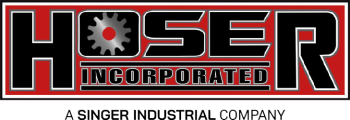Compressing a hose versus minimizing the ferrule OD down to a predetermined size is the main difference between hose crimping and swaging. More specifically, when you use an external swage, you bring the ferrule OD down to a certain size and then force the hose of the tube down into the stem. Comparatively, with hose crimpers, you form a metal sleeve using a series of die segments to compress a hose within a fitting.

So, how do you choose between using hose crimpers and swaging for your application? Generally speaking, swaging exists as the recommended method for uses with oil, petroleum, and composites. Comparatively, most industrial hose applications use hose crimpers because they can be integrated into an automated line, while swaging is more of a hands-on application.
Before deciding to use swaging or hose crimpers for your application, make sure you ask yourself these two key questions:
- Overall, is swaging or using a hose crimper the best fit for the application?
- What type of media and pressure will be going through the hose?
The best advice we can give you is to consult with a team that is highly familiar with industrial hose fittings and accessories, like hose crimpers, for the best results for your application. At HOSER, we are happy to discuss your options when it comes to crimping versus swaging, and we can recommend products that will suit your needs, hose setup, and budget the best. Contact us today to speak with a member of our team!
